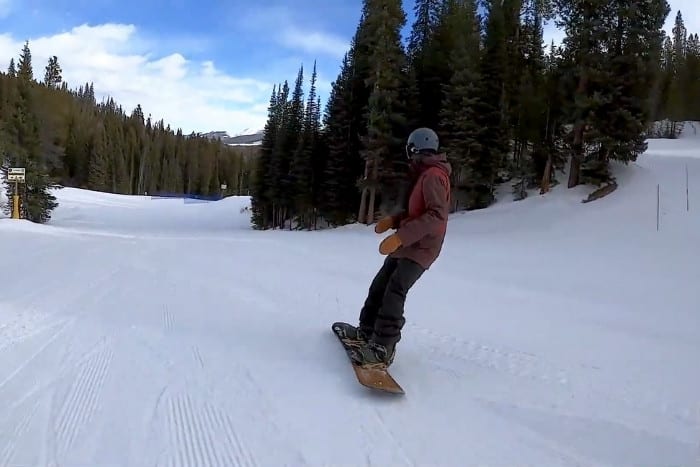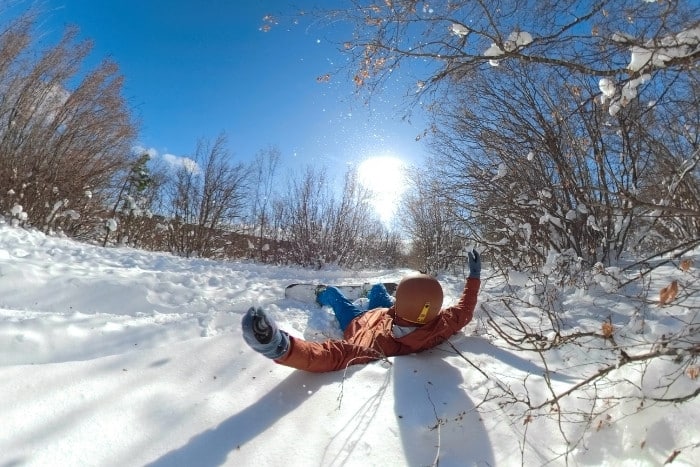Snowboards have various features that give you a choice in your riding experience, depending on your preferences and budget. One important feature to consider is the camber of the board.
The pros of camber snowboards include performance consistency regardless of the snow conditions, high speed, powerful pop, more control, and durability. On the downside, camber snowboards are prone to catching edges, aren’t the best for presses, and are harder to ride in deep powder.
Understanding the advantages and disadvantages of a cambered snowboard will help you make the right purchase when buying a new board.
Pros of a Cambered Snowboard
A cambered snowboard enables you to enjoy fast riding with a fun pop and a lot of power. The design helps you ride more aggressively, offering stability as you turn, despite the high speed.
You also have better edge control, enabling you to stop and carve smoothly.
1. Consistent performance over a wider range of conditions
Camber snowboards are consistent in their performance over a wider range of conditions because they have more contact points with the snow.
This means you can ride the same board in powder, groomers, and park without changing your technique or style.
Their consistent performance also results from their design, which provides the same amount of edge pressure on both sides of the board.
This allows you to ride in any condition, especially when snow changes quickly or drastically. Consistency is advantageous because it allows you to ride one board all season long and improve your craft.
You can focus on getting better instead of keeping up with shifting conditions.

2. Built for higher speed
Cambered snowboards are built to be fast.
They do this by having the contact points towards the tail and nose of the board, which means they have a higher contact with the snow and can transfer more energy from you to your board.
Their shape allows more weight to be distributed over the board’s edges when riding, helping you turn faster and have more control.
Camber snowboards are often a good choice for people who want to go fast and do tricks because they provide better control over their speed and ability to turn quickly. They offer a more aggressive, fun ride.
3. Powerful pop and spring
Camber snowboards provide powerful pop and spring as a result of their construction.
When pushed down by the rider’s weight, the convex curve between the bindings allows for a spring-like transfer of energy when jumping off a kicker or over a roller.
In addition, the cambered profile gives you more edge control, making it easier to pop, and have more control when landing.
The board’s stiffness allows it to snap in a rebound, resulting in a fun pop and spring. It resumes its original shape fast after enabling you to enjoy an edging performance.
Powerful pop and spring are advantages because they allow you to put some muscle behind your moves, whether riding in the park or carving on groomers.
4. Riders have more control
Camber snowboards provide better control because they have better edge control. With better edge control, you can make sharper turns and maneuvers without losing control of your board.
Cambered boards have better edge control as they have a larger area of the board’s edges that come in contact with the snow, known as contact points.
The greater the area of contact points, the more stability a board has.
Contact points also make it easier for you to control the direction the board is heading since it will naturally want to follow the board’s bend.
The cambered design also makes it more stable when carving into turns because they have the greatest amount of surface area touching the snow.
This means that they are less likely to slip out from under you and make you lose control.
5. Durability
Camber snowboards are more durable than other types of boards because they have a flatter profile.
This means that you’re less likely to hit your edges on rocks or other obstacles, and you’ll be able to ride faster without worrying about damaging your board.
Cons of a Cambered Snowboard
Despite the few pros, positive camber snowboards can be challenging to ride on, especially when aiming for a slower ride.
Due to the constant contact between the cambered snowboard’s contact points and the snow, the board can be catchy on cat tracks and challenging to initiate turns.
These factors influence your board to catch an edge, and you may endure a few tumbles until you learn to control your board.
The submarine effect is also rampant on camber snowboards since the contact points dig into soft snow and powder.
1. Easier to Catch an Edge
Turn initiations or riding along the flat may be more of a challenge on a cambered snowboard as you’re likely to catch an edge.
This is because the board’s contact points are closely pressed against the snow, with the edges digging in for control. This can get your board stuck, resulting in a fall.
You may also experience catchy edges on hard-packed snow and when riding icy patches. This also explains why the board may be less forgiving, especially for beginners.

2. The Submarine Effect
When riding a cambered snowboard on powder, the nose often sinks downward slightly, making you have to transfer all your weight onto your back leg to be able to ride through pow without getting stuck.
This puts a lot of pressure on your back leg and will tire you out quickly on pow days. Deep pow rides may require a longer rocker board to avoid the submarine effect.
3. Challenging for Slower Riding
While camber snowboards are praised for their resilience in speed, you may not always be in the mood for fast rides and may opt for slow buttery riding.
However, you can experience challenges when slowing down, buttering, or pressing, given the close contact points between the board and snow.
As mentioned earlier, camber snowboards are more suitable for fast and aggressive rides, requiring more practice to withstand a slow ride.
4. They Can Make Riding Other Boards a Challenge
Camber snowboards are easy to ride on, especially when you are an advanced rider. You require little effort to ride, carve and turn, as long as you know how to apply the correct edge pressure when turning.
Trying other boards like rockers may be challenging if you use a cambered board, as you require more engagement in the turns, carves, and overall riding.
You may need more practice to keep up with boards that lack the pop, spring, and stability that come with a cambered snowboard since it sets you up for a controlled and springy riding experience.
Conclusion
Understanding the pros and cons of a traditional camber snowboard is important as it gives you a glimpse of what to expect when riding on it.
Cambered boards have more pros than cons, which should encourage trying them out.
The pros of cambered snowboards include durability, increased control over your navigation on the slopes, powerful pop, spring, and speed and performance consistency.
However, you may also consider the cons before purchasing a cambered snowboard. Riding on a cambered snowboard exposes you to challenges in turn initiation because they easily catch an edge.
The submarine effect is also a downside, occurring when the board sinks in soft snow or powder. You may also experience challenges when buttering or pressing.
